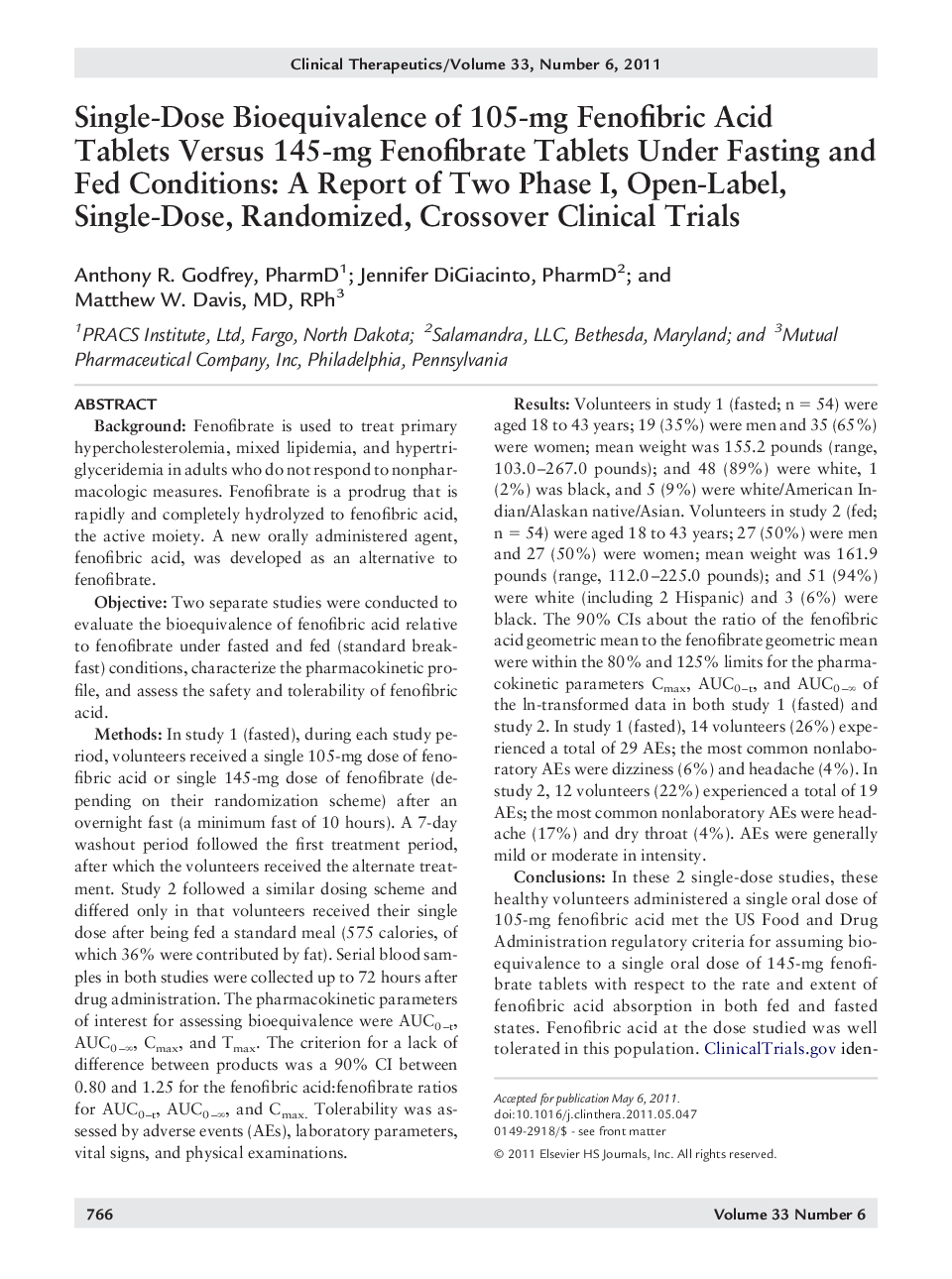| Article ID | Journal | Published Year | Pages | File Type |
|---|---|---|---|---|
| 2527554 | Clinical Therapeutics | 2011 | 10 Pages |
BackgroundFenofibrate is used to treat primary hypercholesterolemia, mixed lipidemia, and hypertriglyceridemia in adults who do not respond to nonpharmacologic measures. Fenofibrate is a prodrug that is rapidly and completely hydrolyzed to fenofibric acid, the active moiety. A new orally administered agent, fenofibric acid, was developed as an alternative to fenofibrate.ObjectiveTwo separate studies were conducted to evaluate the bioequivalence of fenofibric acid relative to fenofibrate under fasted and fed (standard breakfast) conditions, characterize the pharmacokinetic profile, and assess the safety and tolerability of fenofibric acid.MethodsIn study 1 (fasted), during each study period, volunteers received a single 105-mg dose of fenofibric acid or single 145-mg dose of fenofibrate (depending on their randomization scheme) after an overnight fast (a minimum fast of 10 hours). A 7-day washout period followed the first treatment period, after which the volunteers received the alternate treatment. Study 2 followed a similar dosing scheme and differed only in that volunteers received their single dose after being fed a standard meal (575 calories, of which 36% were contributed by fat). Serial blood samples in both studies were collected up to 72 hours after drug administration. The pharmacokinetic parameters of interest for assessing bioequivalence were AUC0–t, AUC0–∞, Cmax, and Tmax. The criterion for a lack of difference between products was a 90% CI between 0.80 and 1.25 for the fenofibric acid:fenofibrate ratios for AUC0–t, AUC0–∞, and Cmax. Tolerability was assessed by adverse events (AEs), laboratory parameters, vital signs, and physical examinations.ResultsVolunteers in study 1 (fasted; n = 54) were aged 18 to 43 years; 19 (35%) were men and 35 (65%) were women; mean weight was 155.2 pounds (range, 103.0–267.0 pounds); and 48 (89%) were white, 1 (2%) was black, and 5 (9%) were white/American Indian/Alaskan native/Asian. Volunteers in study 2 (fed; n = 54) were aged 18 to 43 years; 27 (50%) were men and 27 (50%) were women; mean weight was 161.9 pounds (range, 112.0–225.0 pounds); and 51 (94%) were white (including 2 Hispanic) and 3 (6%) were black. The 90% CIs about the ratio of the fenofibric acid geometric mean to the fenofibrate geometric mean were within the 80% and 125% limits for the pharmacokinetic parameters Cmax, AUC0–t, and AUC0–∞ of the ln-transformed data in both study 1 (fasted) and study 2. In study 1 (fasted), 14 volunteers (26%) experienced a total of 29 AEs; the most common nonlaboratory AEs were dizziness (6%) and headache (4%). In study 2, 12 volunteers (22%) experienced a total of 19 AEs; the most common nonlaboratory AEs were headache (17%) and dry throat (4%). AEs were generally mild or moderate in intensity.ConclusionsIn these 2 single-dose studies, these healthy volunteers administered a single oral dose of 105-mg fenofibric acid met the US Food and Drug Administration regulatory criteria for assuming bioequivalence to a single oral dose of 145-mg fenofibrate tablets with respect to the rate and extent of fenofibric acid absorption in both fed and fasted states. Fenofibric acid at the dose studied was well tolerated in this population. ClinicalTrials.gov identifiers: NCT00961116 and NCT00960687.
